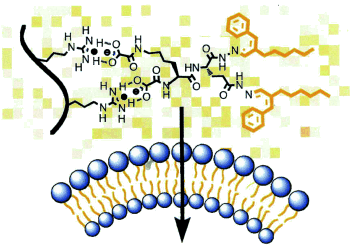- Montenegro, J.; Matile, S. “Anionic Activators for Differential Sensing with Cell-Penetrating Peptides” Chem. Asian J. 2011, 6, 681-689

The design, synthesis, and evaluation of small peptides with one to three negative charges and one to three hydrazides as key components of membrane-based synthetic sensing systems are reported. Their spontaneous reaction with hydrophobic aldehydes or ketones gives rapid access to small collections of amphiphilic anions. These anionic amphiphiles can activate polycations as anion transporters in lipid-bilayer membranes. Odorants are used as representative hydrophobic aldehydes and ketones, and cell-penetrating peptides (CPPs) as polycationic transporters in fluorogenic vesicles. Different activities obtained with different counterion activators are used to generate multidimensional patterns that can be recognized by principal component and hierarchical cluster analysis to extract unique "fingerprints" for individual analytes (including enantiomers, cis-trans isomers or perfumes as illustrative analyte mixtures). Comparison of the peptide activators reveals that carboxylates perform better than phosphonates. Gemini-like activators containing two carboxylates and two hydrophobic hydrazone tails are best, whereas excessive charges and tails give weaker activities. This result differs from cationic activators of polyanionic transporters such as DNA, which worked best with octopus amphiphiles with one cationic head and four hydrophobic tentacles.
open archive unige:13256 • pdf ![]()
